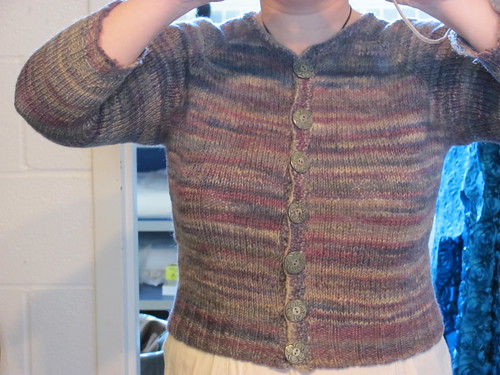The wise are not wise because they make no mistakes. They are wise because they correct their mistakes as soon as they recognize them.
--from Xenocide, by Orson Scott CardAs a kid, school work came fairly easily to me. I could usually get a B on my first effort, which left me free to go outside and play. In high school I worked harder on the first effort and got A's, which left me free for drama club, odyssey of the mind, scholastic bowl, and other geeky fun. It wasn't until college, where there weren't grades, that I was expected to go back into a project and turn in a second draft, or sketch, or sewing sample. I was also expected to take risks and experiment. If done correctly, true risks and honest experiment lead to failure, or at least unexpected results, half the time or more. That means going back and trying again with new variables. At the time, I hated making mistakes. I saw them as failure. If I had done better or known better, I would have gotten it right the first time.
After college in my professional life I still hated mistakes. They felt like failure and I beat myself up over them. This is a tough attitude to live with in technical theater. In theater we experiment. We also adjust the work on our little part once we see how it fits into the whole. We get to a finished product in steps, and we definitely correct our errors. So every time I got to dress rehearsal and got "notes" on my work, listing all the little problems that needed to be fixed for the next night, or changes that would make the costumes look better under the lights, or help the performers wearing them, it felt like failure. If I was better at this I wouldn't get notes.
Luckily, I have come to understand mistakes better. They're not failures. They are part of a process, and only 1 step along the way. The best thing about mistakes is that they can be corrected. It has taken a long time, but I now take joy in identifying the mistakes so that I can correct them. I had to let go of the idea that a first attempt is the only attempt. It is the first step, and it's purpose is to give me everything I need to get to the second step. At work, I make things differently now, with the idea that each step is not being done to finish, but to put me at the best advantage for the second step. And in aiming for a good process rather than an immediate perfect result, and being ready for mistakes, I make fewer. Go figure.
I've been trying to teach my students this, while keeping in mind that I wasn't able to learn it yet when I was them. I definitely see myself in my honor students, for whom high school was easy. Unfortunately, school isn't life, and it turns out that being able to recognize and correct one's own mistakes has much more bearing on successful adult life than being really good at multiple choice test. That's been a real let down, let me tell you.
I knit this cardigan years ago, but thanks to weight gain and an accidental trip through the washing machine, it has gotten rather tight. It's a favorite, my first sweater where I started the process with dirty wool, and then washed, dyed, combed, spun, and knit. So I'm not going to give it up, even if the buttons do gap.
But boy does that look crappy--and it makes me look fat. My friend Becky had mentioned a knitting blog that went step by step through sewing grosgrain ribbon behind your button placket to keep it from gapping. You see this all the time in store bought cardigans, especially the vintage 50's ones. It finally clicked that I could go back and do this to a sweater even though it was already finished. And boy was it worth going back in and fixing that, even years later.

This is the inside of each button band--buttons on the right and holes on the left. I used a wide (about 7/8") grosgrain behind the buttons, then removed them and re-stitched them going all the way through the sweater and the grosgrain. I used 2 narrow bands (1/4-3/8") on the buttonhole side running down either side of the vertical buttonholes. Both were whipped in by hand and none of the stitching shows in front.

Much better! Whether you call it fixing a mistake, or taking the next step in a project, the improvement is well worth the time it took! At some point I'm going to go back into a number of my cardigans and do the same.
If you're not making mistakes, you're not trying hard enough!
--Miss Havisham in "The Well of Lost Plots" by Jasper Fford

